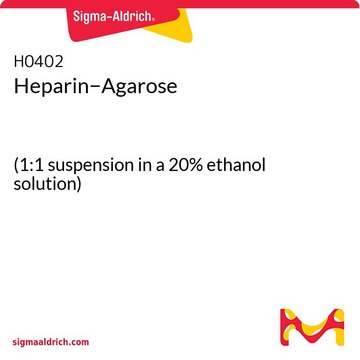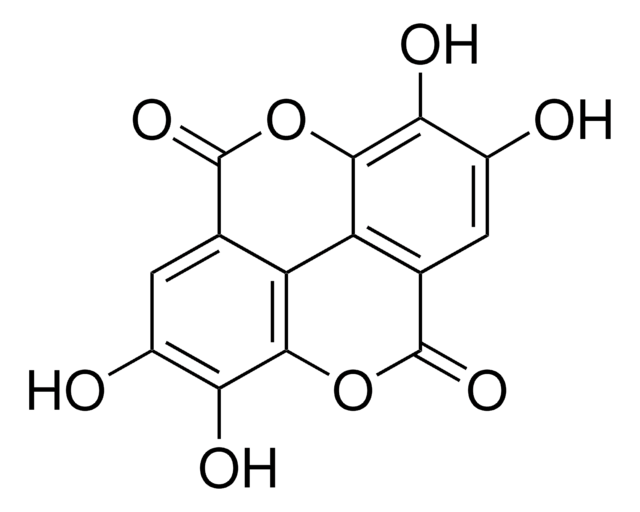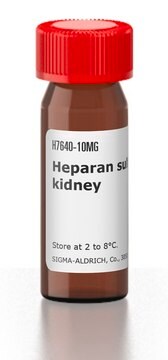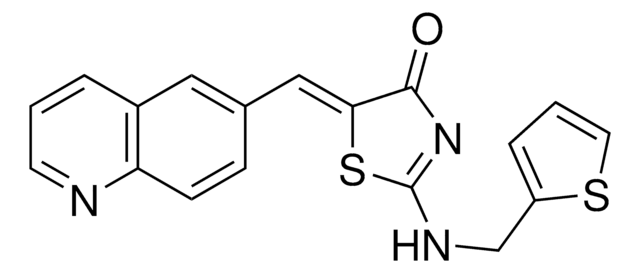H6508
Heparin−Agarose
Type I, saline suspension
Synonym(s):
Heparin beads, Heparin resin
Sign Into View Organizational & Contract Pricing
All Photos(1)
About This Item
Recommended Products
biological source
heparin from Porcine intestinal mucosa
Quality Level
type
Type I
form
saline suspension
extent of labeling
400-1500 μg per mL packed gel (activity approx. 140 USP units per mg)
technique(s)
affinity chromatography: suitable
matrix
cross-linked 4% beaded agarose
matrix activation
cyanogen bromide
matrix attachment
amino
matrix spacer
1 atom
suitability
suitable for chromatography
storage temp.
2-8°C
Looking for similar products? Visit Product Comparison Guide
Application
Heparin-agarose is developed from porcine intestinal mucosa and is used in affinity chromatography. Heparin-agarose has been used in studies to provide information on human monocytic ehrlichiosis, tumor necrosis and the effects of coagulation from Vipera snake venom.
Physical form
Suspension in 0.5 M NaCl containing preservative
Storage Class Code
10 - Combustible liquids
WGK
WGK 3
Flash Point(F)
Not applicable
Flash Point(C)
Not applicable
Personal Protective Equipment
dust mask type N95 (US), Eyeshields, Gloves
Choose from one of the most recent versions:
Already Own This Product?
Find documentation for the products that you have recently purchased in the Document Library.
I V Kaplan et al.
Atherosclerosis, 158(2), 455-463 (2001-10-05)
Oxidation of beta-lipoproteins has been linked to the development of arteriosclerosis. Using a copper mediated cell free system to oxidize beta-lipoproteins, we found that beta -lipoproteins isolated from plasma were less susceptible to oxidation than lipoproteins from serum and that
D A Willins et al.
The Journal of biological chemistry, 266(17), 10768-10774 (1991-06-15)
Exogenous leucine affects the expression of a number of different operons in Escherichia coli. For at least some of these operons, the leucine-related effect is mediated by a protein called Lrp (Leucine-responsive regulatory protein). The purification of Lrp to near
M E Silvestri et al.
Scandinavian journal of immunology, 53(3), 282-289 (2001-03-17)
An investigation was performed into the heparin-binding properties of a synthetic peptide deduced from the sequence of human cytomegalovirus glycoprotein B. The peptide, T7-13:3, amino acids 69-78, which was previously shown to contain a neutralization epitope was able to bind
Alejandra Loyola et al.
Methods (San Diego, Calif.), 31(1), 96-103 (2003-08-02)
It is becoming clear that the structure of cellular chromatin is dynamic and capable of undergoing rapid changes to respond to the metabolic requirements of the cell. These changes have a direct impact on gene expression and, therefore, the chromatin
G Glaser et al.
Archives of virology, 143(10), 1967-1983 (1998-12-18)
The immediate early BRLF1 and BZLF1 promoters of Epstein-Barr virus are crucial for triggering the replicative cycle of the virus. To better understand the cell type dependence of the lytic cycle we conducted an analysis of the BRLF1-promoter in the
Our team of scientists has experience in all areas of research including Life Science, Material Science, Chemical Synthesis, Chromatography, Analytical and many others.
Contact Technical Service







